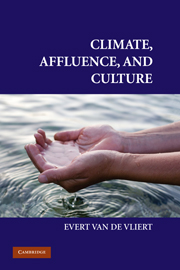Book contents
2 - Climate Colors Life Satisfaction
from PART TWO - CLIMATE, CASH, AND WORK
Published online by Cambridge University Press: 21 August 2009
Summary
No plant, no animal, no human is indifferent to cold and heat.
Dotted around the globe are many ancient buildings and structures left behind by societies that collapsed or vanished. Not infrequently, these monuments provide stark evidence of the part extremely cold and hot climates can play in human civilizations (Burroughs, 1997; Diamond, 2005). From the Norse who once lived by the shores of iceberg-strewn fjords on Greenland's west coast to the Maya who once lived in the seasonal-desert environment of the Copán Valley in western Honduras, past societies seem to have been overwhelmed by the effects of prolonged adverse weather. Even today, vast areas around the poles are rendered uninhabitable by ice sheets, and huge deserts at lower latitudes are equally effective in limiting human population. Human societies clearly tend to shun overly demanding cold and hot climates.
As elucidated in Chapter 1, humans have a physical and a cultural side. The existence of physically inhospitable areas in harsh climates automatically raises the question, therefore, whether climates also create culturally inhospitable areas – parts of the world where climate has shaped the inhabitants' lifestyle to be so strange and inconsistent that it is extremely difficult for others to make their way there. Or is this a nonissue? No one calls into question that life in the vegetable world and in the animal world has adapted to cold, temperate, and hot climates.
- Type
- Chapter
- Information
- Climate, Affluence, and Culture , pp. 31 - 56Publisher: Cambridge University PressPrint publication year: 2008
- 1
- Cited by

